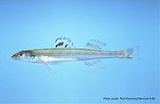
Ammocrypta
Encyclopedia
Sand darters are a genus, Ammocrypta, of perches
native to Canada
and the continental United States.
Percidae
The Percidae are a family of perciform fish found in fresh and brackish waters of the Northern Hemisphere. The family contains about 200 species in ten genera...
native to Canada
Canada
Canada is a North American country consisting of ten provinces and three territories. Located in the northern part of the continent, it extends from the Atlantic Ocean in the east to the Pacific Ocean in the west, and northward into the Arctic Ocean...
and the continental United States.
Species
- Naked sand darter, Ammocrypta beanii JordanDavid Starr JordanDavid Starr Jordan, Ph.D., LL.D. was a leading eugenicist, ichthyologist, educator and peace activist. He was president of Indiana University and Stanford University.-Early life and education:...
, 1877. - Florida sand darter, Ammocrypta bifascia Williams, 1975.
- Western sand darter, Ammocrypta clara JordanDavid Starr JordanDavid Starr Jordan, Ph.D., LL.D. was a leading eugenicist, ichthyologist, educator and peace activist. He was president of Indiana University and Stanford University.-Early life and education:...
& Meek, 1885. - Southern sand darter, Ammocrypta meridiana Williams, 1975.
- Eastern sand darterEastern sand darter-Abstract:Ammocrypta pellucida, also known as the eastern sand darter, is a species of the Percidae family. The eastern sand darter is a relatively small, perch-like fish that has recently been listed as globally threatened in the areas in occupies throughout Canada and the eastern United States...
, Ammocrypta pellucida (Putnam, 1863). - Scaly sand darterScaly sand darterThe scaly sand darter is a species of freshwater fish endemic to the southeastern United States.-Description:The scaly sand darter grows to between in length. It has nine to sixteen spots on each side, with irregular dark blotches on the back, with dark bands on the dorsal, caudal and spinal fins...
, Ammocrypta vivax Hay, 1882.

